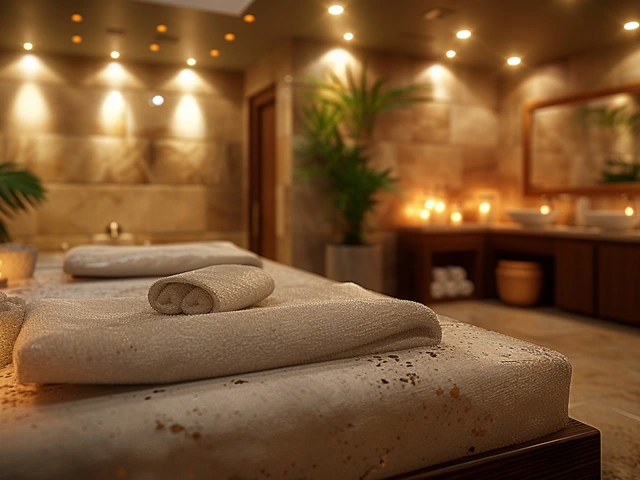Trigger Point Massage Therapy: Unlocking Real Pain Relief Secrets

Have you ever poked a sore spot in your shoulder and felt pain shoot up your neck or down your arm? That's not magic, it's muscle science. Those spots, called trigger points, have a sneaky way of ruining your day—yet hardly anyone talks about how simple it can be to treat them. Most people ignore muscle aches until they're wincing just from tying their shoes or picking up the groceries. You'd be amazed how easily a few targeted techniques can melt away these pains and even stop them from coming back.
What Are Trigger Points & Why Do They Cause So Much Trouble?
It’s weird but true—your muscles can ‘remember’ stress. If you’ve ever experienced tense shoulders after a tough week at work, you get the idea. When muscles don’t fully relax, tiny, tender knots can form. These knots, known as trigger points, can be as small as a pea but pack a punch that’s way above their size. They send pain not just right where they are, but also to nearby or even distant spots. So a knot in your back might actually cause headaches or numbness in your arms. Sounds wild, right? But studies going all the way back to Dr. Janet Travell in the 1940s—yes, JFK’s personal physician—showed how these trigger points are the real villains behind tons of chronic aches and pains.
Imagine your body as a big, complicated network of cables. If one cable gets a twist or tangle, tension builds up in all the connected lines, sometimes far from the original problem. Trigger points work the same way inside your muscles: they mess with your body's wiring and cause issues you’d never expect. Headaches, neck pain, sciatica, even jaw tension—they’re all linked to these little knots that most people never think to check. And get this: research has found that up to 85% of chronic pain patients have at least one major problem area caused by trigger points. That’s a massive number, considering how rarely doctors talk about them!
So how do these annoying knots even form? The main culprits are things most of us deal with every day: bad posture (think hunched over your phone), overuse (hello, laptop warriors), injuries, and even stress. When your nervous system stays on high alert, your muscles stay tense—and a tense muscle doesn't get enough blood or oxygen, which means the waste products from cells build up, and knots form. Unlike normal muscle tension, these trigger points don't just go away by themselves. If you push on one, you’ll not only feel pain right there—you'll feel it radiate somewhere else. That’s called referred pain, and it’s one of the clearest signs you’ve found the troublemaker.
Doctors and researchers have created detailed “trigger point maps” for just about every muscle group in your body. The surprising part? Most massage therapists and regular folks haven’t seen these maps, even though they can literally guide you to the source of 80% of your everyday pain. So, if you’ve ever thrown money at fancy painkillers or endless physical therapy appointments without results, it might be time to look for the ‘hidden’ knots actually causing your discomfort.

Trigger Point Massage: How It Actually Works & Why It’s Not Your Average Back Rub
Now let’s clear up one thing—trigger point massage isn’t some soft, spa-style rubdown. This is hands-on detective work, more like working out a tough knot in a shoelace than just gliding around the skin. Real trigger point therapy means finding that tiny, specific spot and holding pressure there until the muscle “lets go.” Sound intense? Sometimes it is, especially if those knots were ignored for months or even years. But most people are surprised at how much relief they feel right after, almost like turning off an irritating car alarm that’s been stopping you from sleeping.
The method depends on using firm, steady pressure—either with your fingers, thumbs, an elbow, or even tools like a massage cane or a tennis ball (seriously). That pressure interrupts the nerve signals causing the muscle to keep tightening. With the knot distracted, blood rushes back in, fresh oxygen gets delivered, and the body finally clears away waste that’s built up. The result? Your body can finally switch off the pain signals and start healing.
One cool thing: you don’t always need a professional massage therapist. While skilled hands help, anyone can try self-care at home. Got a stubborn knot in your upper back? Lean against a wall with a tennis ball and slowly move back and forth—the ball will find those tight spots for you. There’s even research backing this up from the American Pain Society: patients who tried targeted self-massage on trigger points saw a 50% reduction in their pain after just two weeks. Just don’t go overboard, especially if it’s your first time—it takes practice to know when you’re helping vs. just bruising yourself. Start gentle, hold for about 30 seconds to a minute, and wait for the pain to “melt” or ease. If it feels like white-hot pain or you feel numbness, stop and try a softer touch.
- Tip: Warm up the area first to make the process a little easier. A heating pad, warm towel, or even a hot shower loosens up tight muscles before you dive in with pressure.
- Tip: Drink extra water after working out your knots. Flushing out the waste products your muscles release can stop next-day soreness.
- Tip: Breathe deeply during the massage. It helps your nervous system go from "fight or flight” to relaxation—making release easier and longer-lasting.
Some massage therapists use extra tools like silicone cups, vibration devices, or ice packs to amp up trigger point release. Athletes swear by it—not just for pain relief, but for getting extra flexibility and speeding up muscle recovery. And if you’re the type who works at a desk all day or drives long hours, adding a short trigger point massage routine each week can keep you from ending up stiff, sore, and cranky.
But there’s another secret: you can actually prevent some trigger points from forming in the first place. Simple daily moves, like stretching, standing up for ‘micro-breaks’, or switching up your sitting position, keep muscles happier. Ever seen an office worker doing shoulder rolls or neck stretches every hour? They’re not just fidgeting—they’re making sure muscle knots never get a chance to settle in. The trick is being consistent, even when you don’t feel sore. Think of it as the maintenance that keeps your body’s ‘wiring’ untangled and working right.

Who Should Try Trigger Point Massage—and When To Call In the Experts
This therapy isn’t just for hardcore gym goers or sports pros. Anyone who’s ever woken up with a stiff neck, dealt with nagging headaches, or felt back pain from hours at a keyboard can get results. Studies from the National Institutes of Health show trigger point massage boosts flexibility and cuts down joint pain—especially helpful for people with repetitive stress injuries, like carpal tunnel or desk-job burnout. Even folks dealing with fibromyalgia or chronic fatigue report a softer, more relaxed feeling in their worst pain zones after trying this method. Trigger point work is especially handy for new moms (hello, upper back aches from lifting babies) or people with jaw problems from clenching their teeth at night. In one real-world study, more than 80% of office workers with neck pain felt better after just a single targeted session.
But, let’s keep it real—trigger point massage isn’t a cure-all. There are situations when you need to see a pro. If your pain is sharp, sudden, or paired with symptoms like tingling, muscle weakness, or trouble moving, stop and talk to a healthcare provider. Sometimes knots hide more serious problems. Also, go easy if you take blood thinners, have a bleeding disorder, or skin problems in the sore area. And remember, not all pain comes from trigger points. Sometimes, what you think is a muscle knot is actually something deeper, like a herniated disc or even an infection—rare, but worth checking for if things don’t feel right.
Working with a trained massage therapist can make the process safer and more effective, especially for areas you can’t reach (like the middle of your back). They can also spot related muscle patterns and give you custom advice. Many therapists integrate trigger point work with other methods, like stretching and joint mobilization, for a bigger, longer-lasting effect. Want a tip from the pros? Ask if they use trigger point charts or maps—seeing exactly which spots connect to your pain can be a game-changer. And never be afraid to ask questions during your session. Real therapists want you to understand what’s happening, not just zone out and hope for the best.
If you’re just getting started at home, pick up a lacrosse ball or foam roller—they’re cheap, easy to use, and make it simple to work on tricky spots. There are dozens of free video tutorials online. Start with major ‘hotspots’ like the upper shoulders, back of the neck, or glutes. Remember, slow and steady wins the race. Don’t dig so hard you see stars. A good sign you’re on the right track? After a minute of gentle pressure (on a scale from 1–10, aim for a 5–7), the pain should fade or spread out, not get sharper. And if you hear a pleasant ‘pop’ or your muscle suddenly relaxes, you’ve likely just untied a problem that’s been there for way too long.
- Headache relief can come from trigger points in your upper back and shoulders, not just your temples.
- Pain in the side of your leg? Check the knots in your hip flexors before you go blaming your knee.
- If you have lingering pain after an old injury, look for nearby muscles doing ‘overtime’ to protect the area—these are prime locations for trigger points.
It’s funny how something so simple, even a firm thumb or a bouncy ball, can make such a big difference in how you feel every day. People who add trigger point massage to their self-care routines often say it’s like finding a reset button for their bodies—suddenly they’re looser, lighter, and moving with less effort. If you’ve been quietly suffering, maybe it’s time to try the hands-on secret your muscles have been craving.





